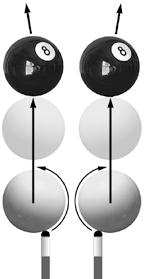Squirt And Throw
by Jim Meador
"Squirt"
The "squirt" phenomenon has always been a factor in pool. Only
recently, however, and partly due to the increased competition by cue
makers for new customers, has the issue reached a boiling point.
The only way I can relate to the subject, and present it to
readers as best I know how, is to share my experience with the
anomaly.
 When I started playing pool in the late 50's,
there were few instruction books, no upscale billiard parlors, and
very little concern about the physics of the game &endash; especially
among rank and file shooters. There was little if any TV coverage of
pool in those days, and the only instructors I remember were pool
hustlers who would "teach" you for a buck a game.
When I started playing pool in the late 50's,
there were few instruction books, no upscale billiard parlors, and
very little concern about the physics of the game &endash; especially
among rank and file shooters. There was little if any TV coverage of
pool in those days, and the only instructors I remember were pool
hustlers who would "teach" you for a buck a game.
I would practice alone, or with friends in a pool hall, and watch
the "experts" on another table playing one pocket or cribbage. Pill
pool was also popular back then, but I never took an interest in the
game.
I learned to shoot with a house cue. All I looked for was a
straight stick with a good tip, and the thought of shaft stiffness or
whippiness never crossed my mind. Of course, all house sticks were
stiff, because none were pro-tapered, and they were made tough and
cheap to survive the environment. So, although I always shot with a
different cue, they all acted the same way. Squirt existed, but I
must have automatically compensated for it when I aimed. So, what is
"squirt?"
Obviously, whenever we hit the cueball with a stroke that is off
center, it is vulnerable to sliding off the tip of the cue stick.
This is nothing new to those who have miscued. Hit too far to the
outside edge of the cueball and it will deflect (squirt) off the tip
and leave the intended aiming path. A whippy shaft can exacerbate the
problem.
With the introduction of pro-tapered cue sticks to the general
pool playing population, the more flexible shafts increased the
vulnerability of miscues due to the increased (or at least different)
deflection of the cueball off the tip. In fact, those who shoot with
flexible shafts must compensate more, often subconsciously, for the
squirt anomaly.
The illustration shows the effect of squirt. Notice that the
contact point on the object ball is changed from center, to left of
center. So, if you are missing shots consistently to the right of the
pocket using right english, maybe squirt is the the culprit. Try
reducing the amount of english used. The same is true of left
english, but with opposite ball action.
"Throw"
 While squirt is undesirable, "throw" may or may
not be, depending on the skill of the player. Throw can be used to
your advantage once the amount can be controlled. It is almost
impossible to control the amount of squirt.
While squirt is undesirable, "throw" may or may
not be, depending on the skill of the player. Throw can be used to
your advantage once the amount can be controlled. It is almost
impossible to control the amount of squirt.
Throw is the effect a spinning cueball has on the object ball, and
it is always present when side spin is used, either alone or in
combination with top or bottom.
Throw is caused by ball friction. When the cueball hits the object
ball while it is spinning, the spin friction will "throw" the object
ball slightly in a direction opposite the english used. The
illustration at left shows the object ball being thrown left with
right english. An object ball can be thrown 4 to 6 inches over the
length of the table, and when you learn to use it, a throw shot can
be as dependable as a cut shot if it falls safely within the throw
window.
Many players compensate for throw when cutting a ball by applying
a little outside spin to the cueball. Others compensate by cutting
the ball a fraction thinner.
Unless you are really into the physics of the game, it is best to
stay focused on aiming and learn to compensate for various anomalies
subconsciously. Just know squirt & throw exists.
Billiard World Home
Page

 When I started playing pool in the late 50's,
there were few instruction books, no upscale billiard parlors, and
very little concern about the physics of the game &endash; especially
among rank and file shooters. There was little if any TV coverage of
pool in those days, and the only instructors I remember were pool
hustlers who would "teach" you for a buck a game.
When I started playing pool in the late 50's,
there were few instruction books, no upscale billiard parlors, and
very little concern about the physics of the game &endash; especially
among rank and file shooters. There was little if any TV coverage of
pool in those days, and the only instructors I remember were pool
hustlers who would "teach" you for a buck a game. While squirt is undesirable, "throw" may or may
not be, depending on the skill of the player. Throw can be used to
your advantage once the amount can be controlled. It is almost
impossible to control the amount of squirt.
While squirt is undesirable, "throw" may or may
not be, depending on the skill of the player. Throw can be used to
your advantage once the amount can be controlled. It is almost
impossible to control the amount of squirt.